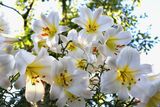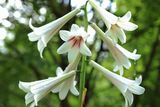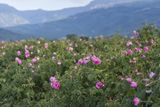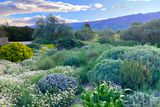Sea pink is a thrifty little coastal plant
Sea Pink
Sea pink is in flower these days, not just in gardens, but by the coast that is its natural habitat. It has very pretty tufts of light pink or dark pink flowers on wiry stems held well about the narrow linear, grassy leaves. When seen out of flower, it could easily pass for a tuft of short seaside grass. But now and through the summer, the plants produce with their showy flowers.
It is also known by the common name of thrift, or armeria, which is its botanical name. It gets the name of sea pink as it grows by rocky shores around the coast, more plentiful in some places than others. The thrift name derives from the very spartan conditions in which it grows, usually in a patch of soil at the edge of a sea-side bank, or a crack in a rock with some soil or seaside detritus. It hangs on tenaciously in these spots, resisting the direct damage of salt water spray, seaside gales and windblown sand.
The narrow leaves are ideal for moving in the wind to avoid damage and they are tough and waxy to reduce the danger of desiccation. The flower stems are equally tough and wiry, up to 30 centimetres tall, though usually less than half that height by the coast, the plants not growing as much when challenged by severe exposure to wind. Old plants often reveal how they survive, exhibiting a tough woody root, very small but strong, that connects with the roots which grow down deeply into the poor available soil.
Grown in gardens, it grows bigger, though sometimes with a lot of grassy leaves and just a smattering of the little flowers, especially when the plants are shaded for even part of the day. It is naturally adapted to full open sunshine and performs much less well if at all shaded. The natural habitat of the plant gives clear clues as to what it requires, namely, not overly rich, well-drained soil in full sunshine.
This little plant can be a jaunty addition to any garden and is particularly suitable for use in a small garden where space is limited, and ideal for a coastal garden. It is not in the least tender, so it does not need to be grown in a coastal garden - but it somehow looks more at home there. There are various selected kinds in richer pink colours, such as 'Vindictive' which is deep rosy red. 'Bee's Ruby' is dark pink and tall, about 30 centimetres. At a distance, it resembles a tuft of flowering chives. 'Bloodstone' has dark red flowers. But the ordinary sea pink or a version of it is the one most widely seen. The plant is very long-lived, free of disease and apparently pest-free too. Over time, it forms a broad mat of foliage and is perfect at the front of a border, on a bank or in a rock garden.
Join the Irish Independent WhatsApp channel
Stay up to date with all the latest news














